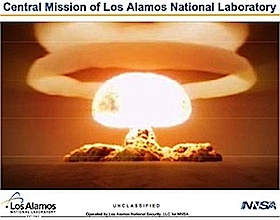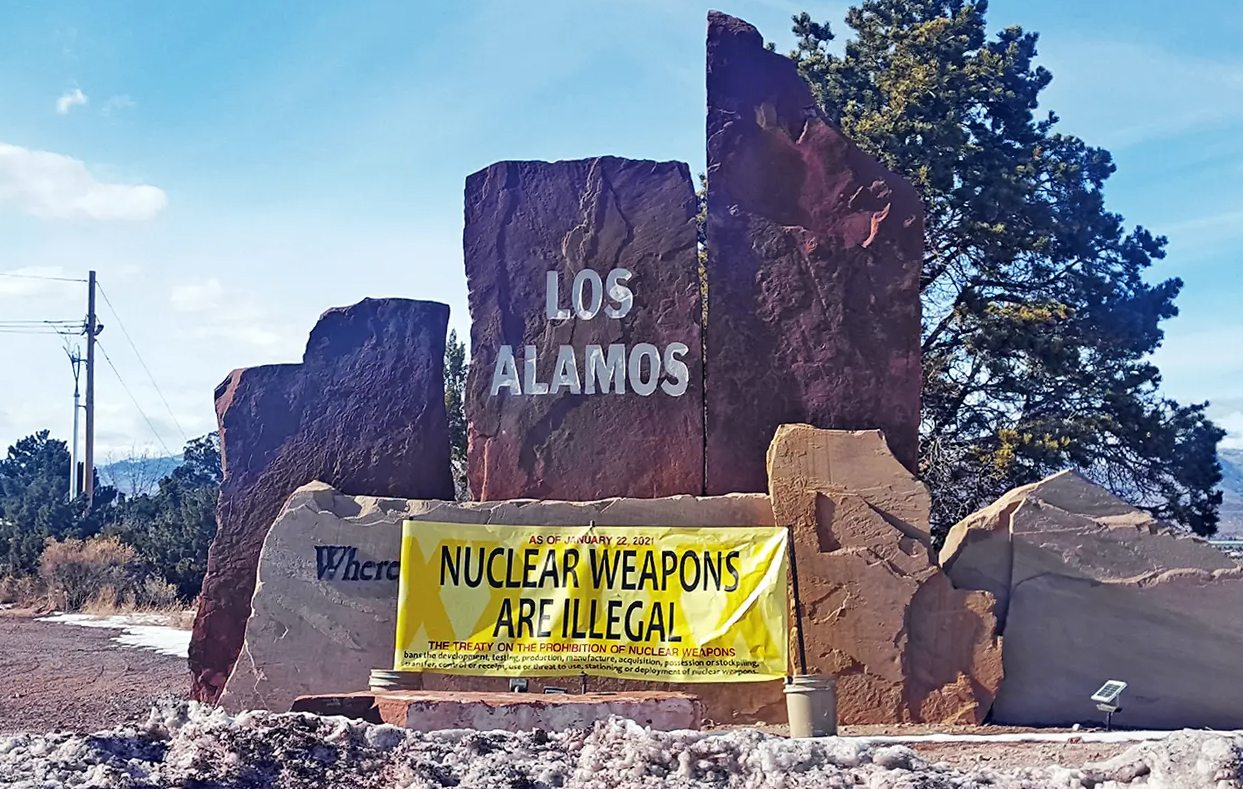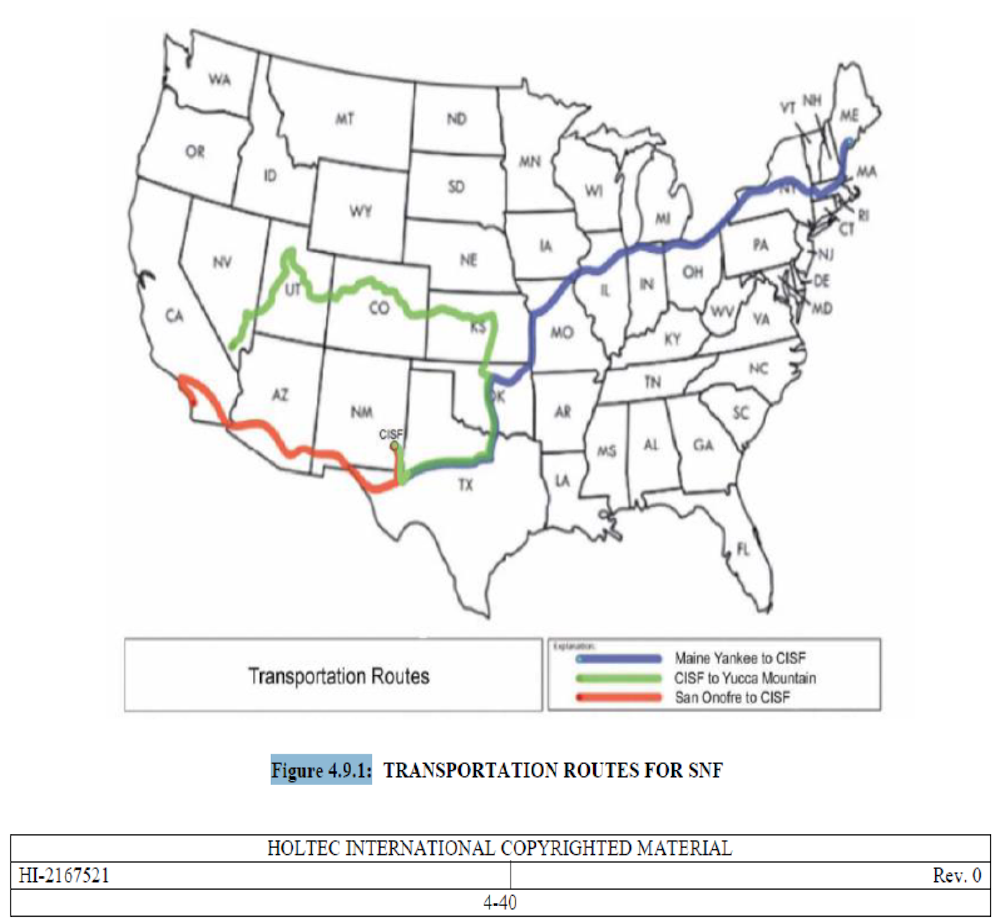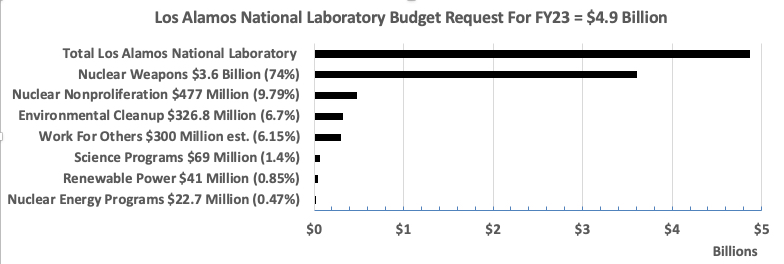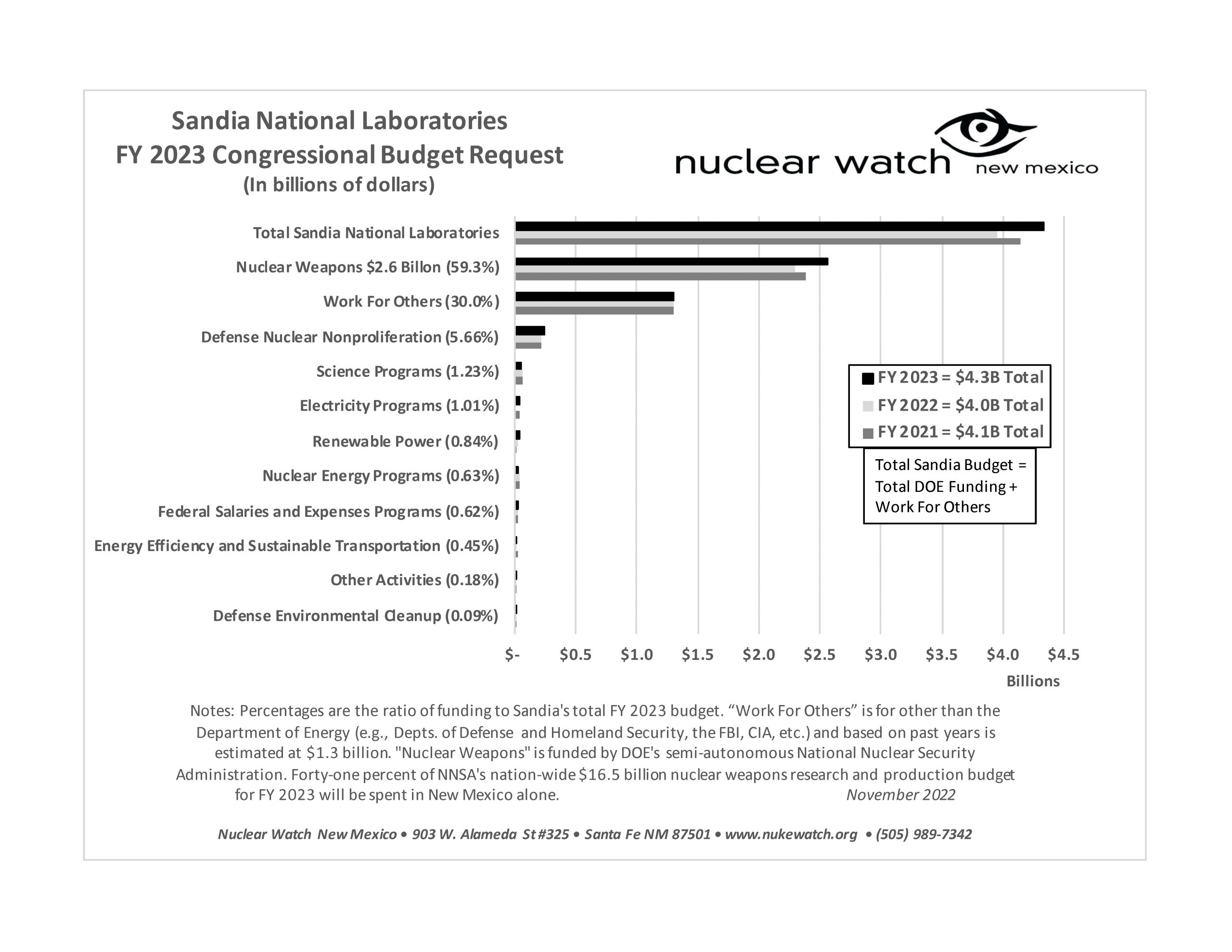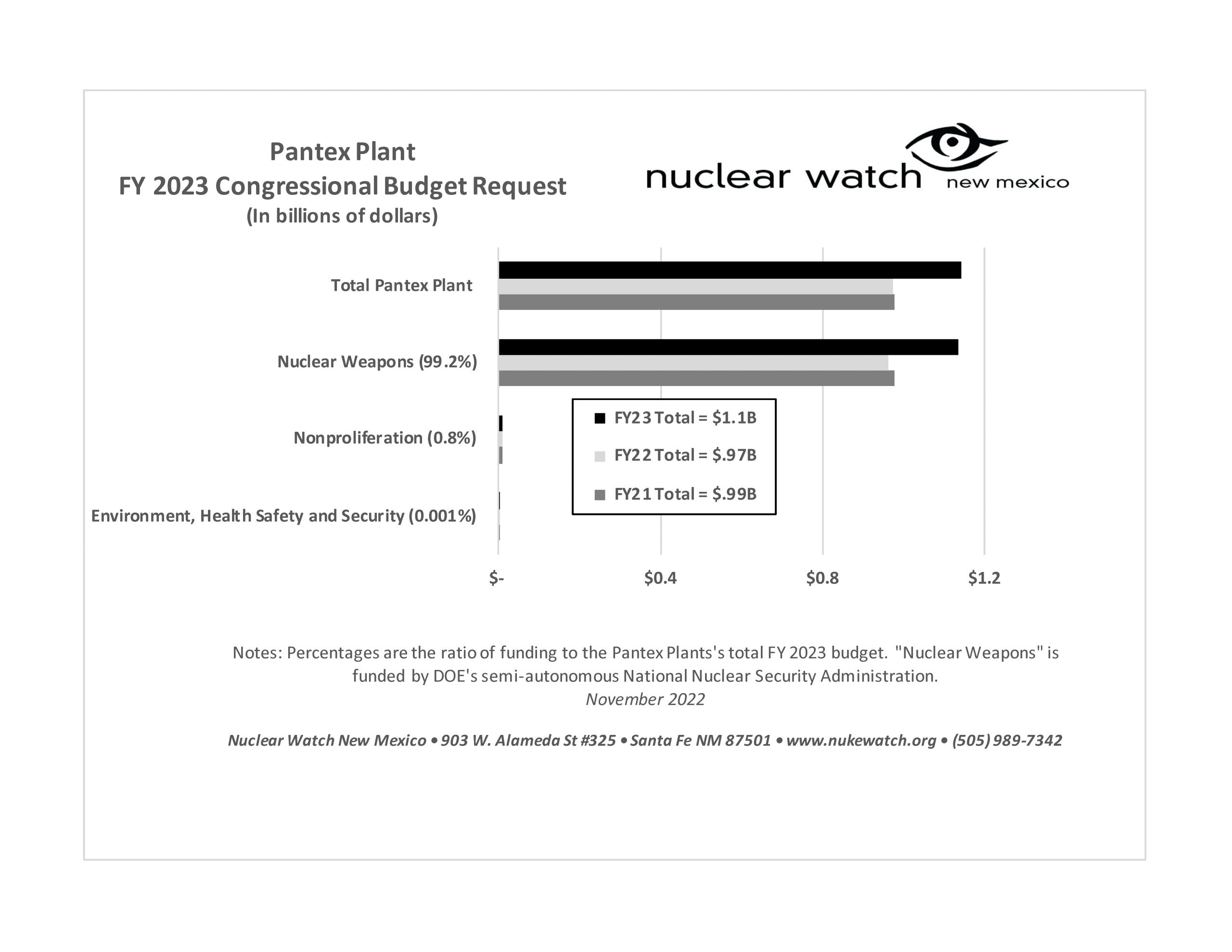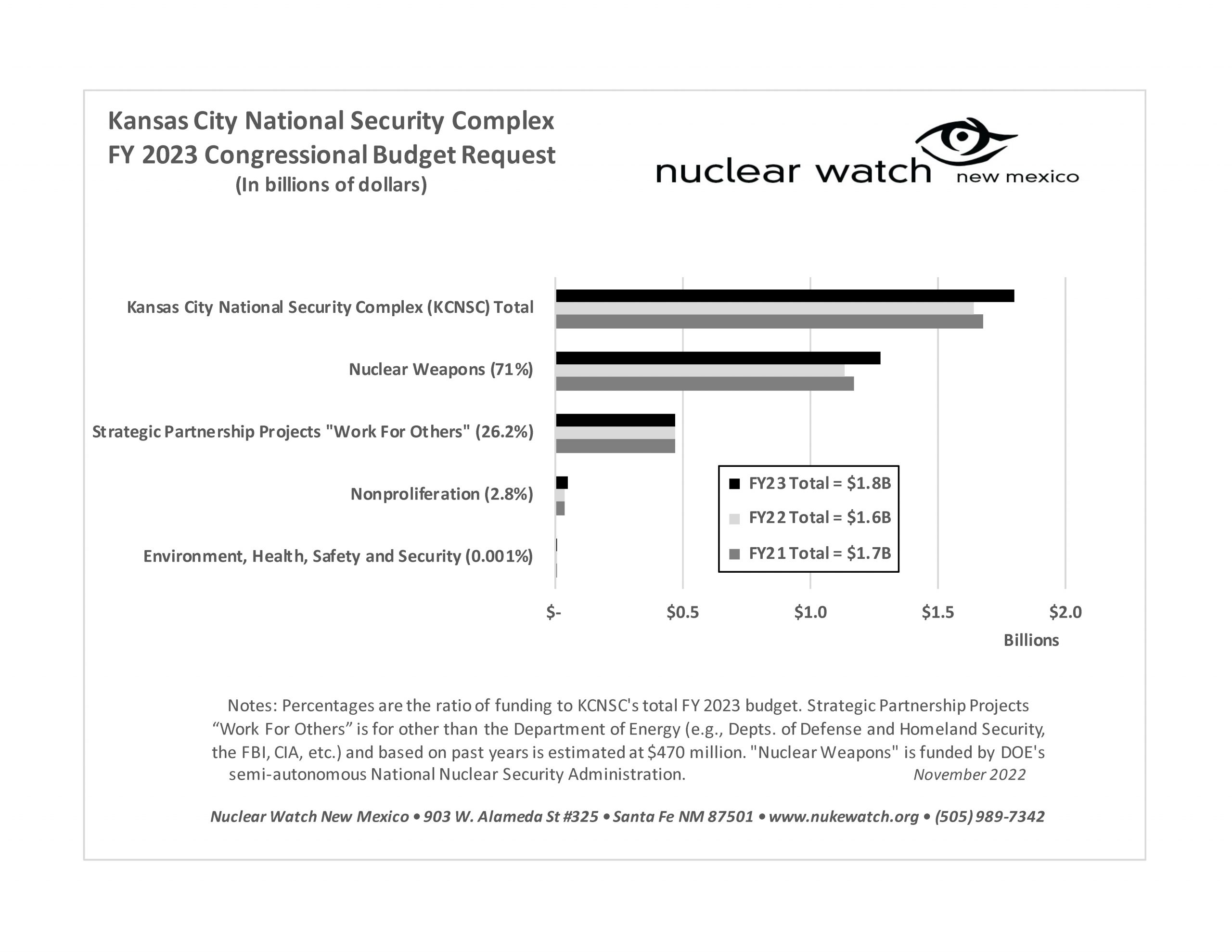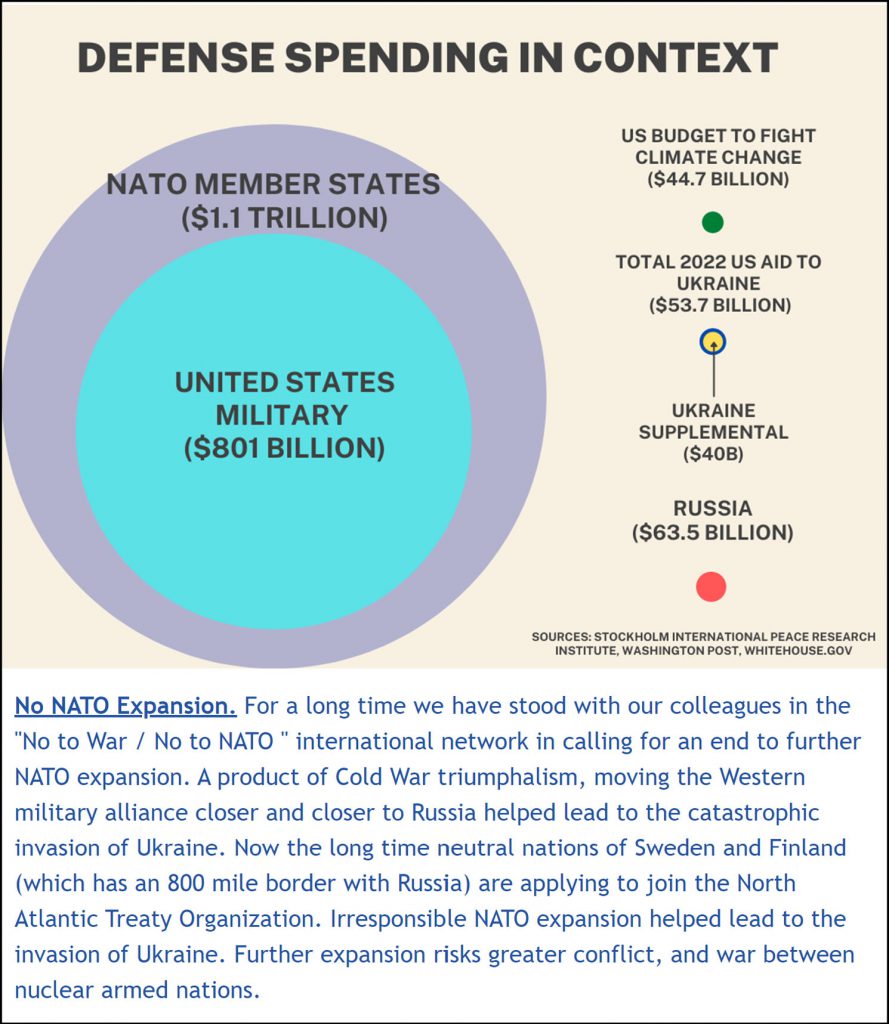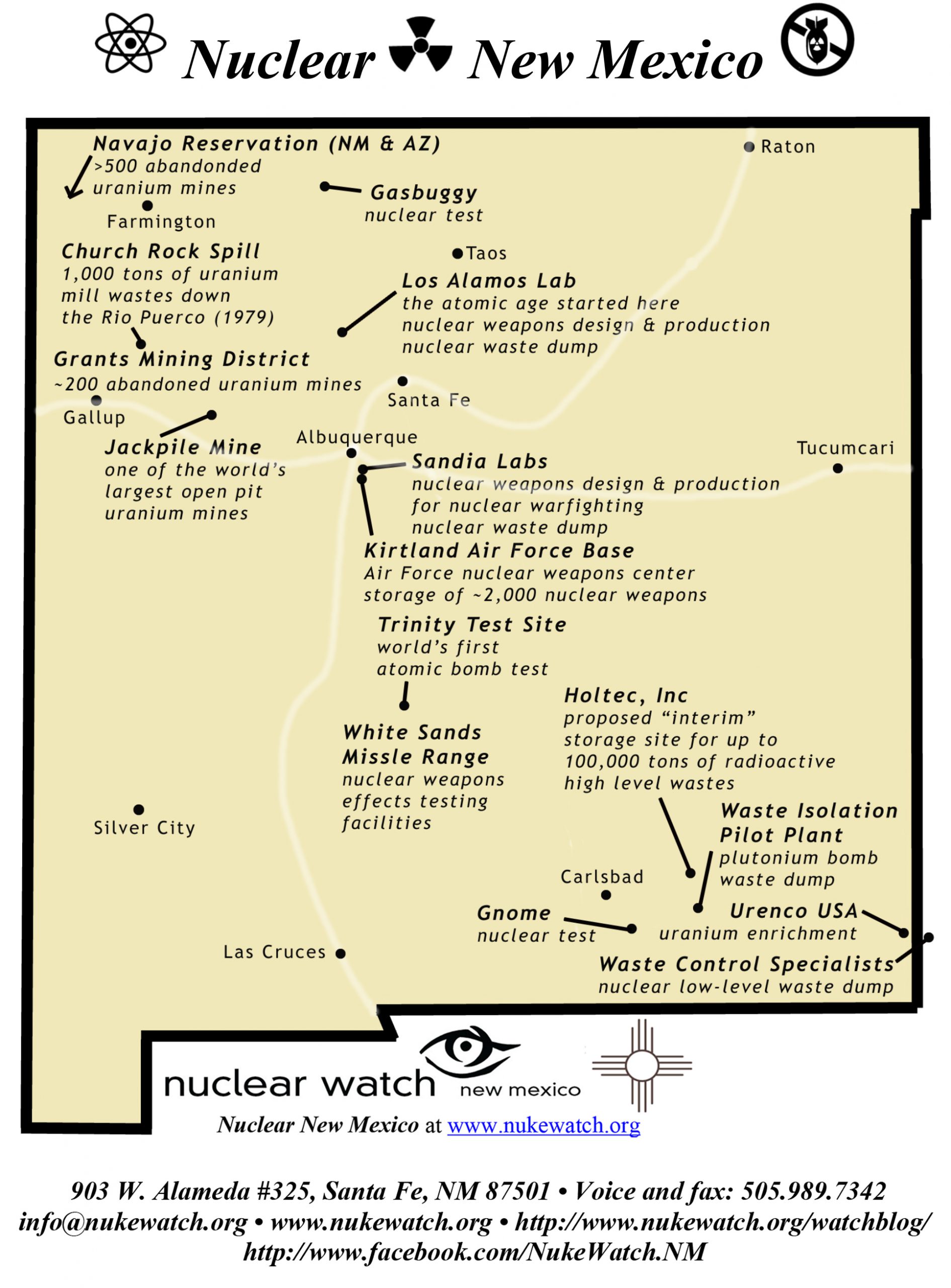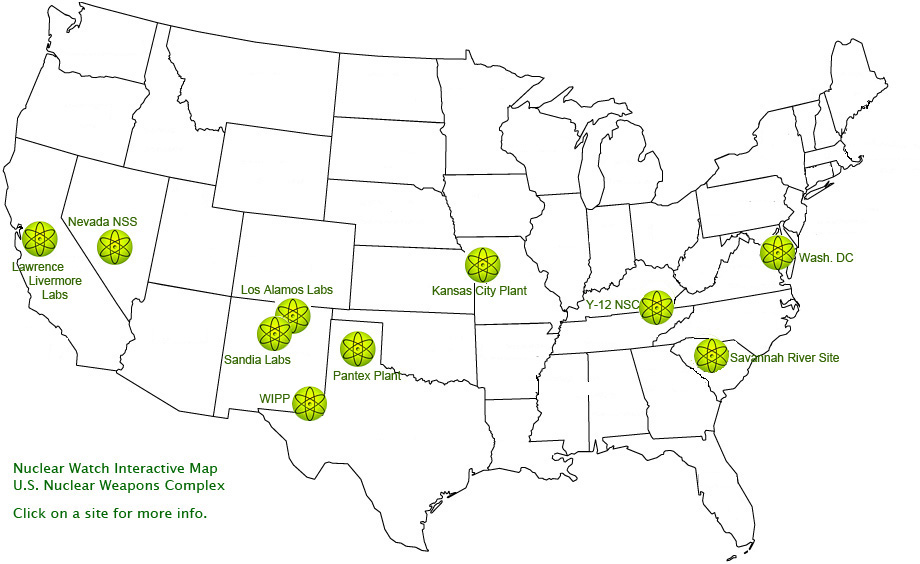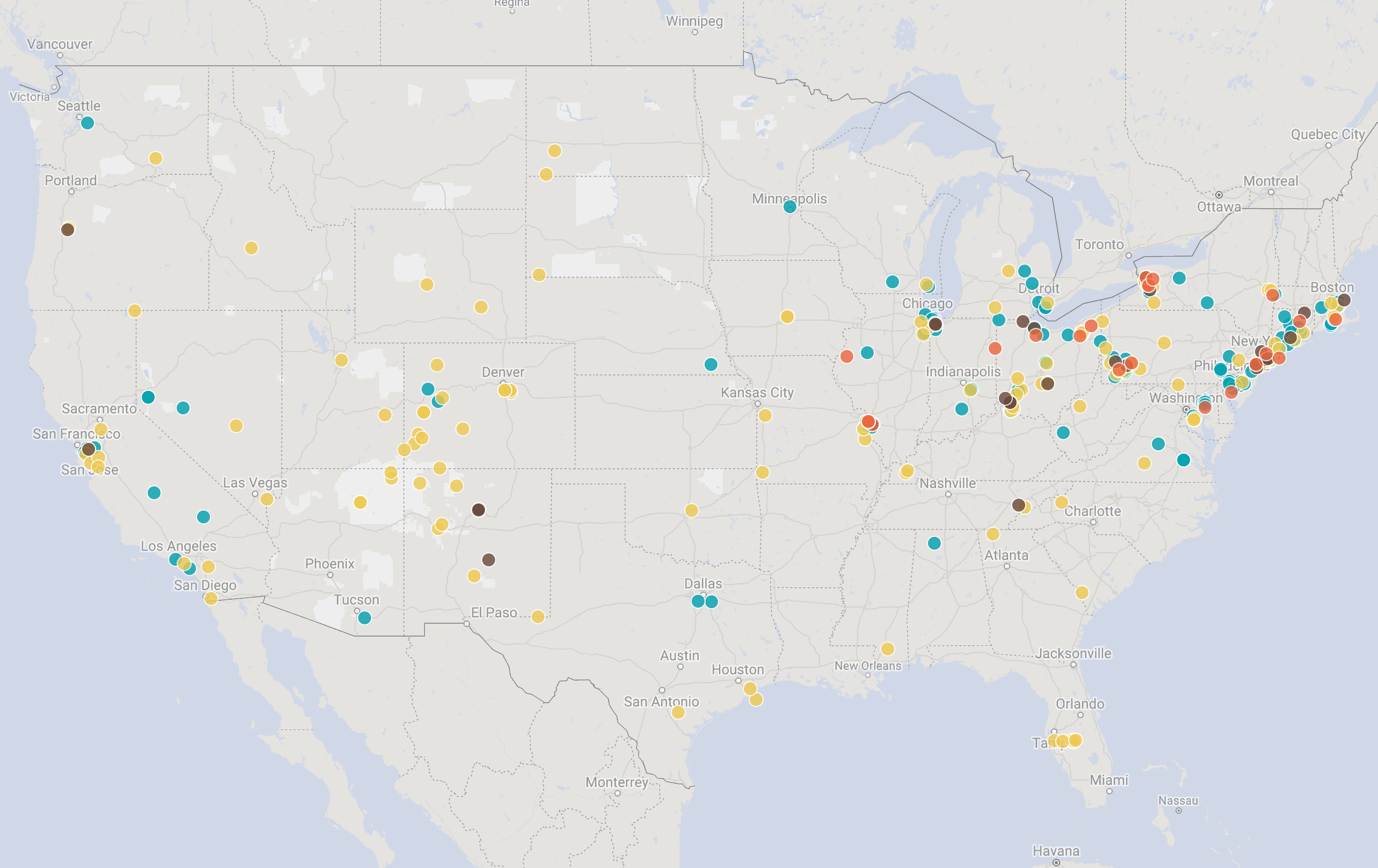QUOTE OF THE WEEK
Nothing Found
It seems we can’t find what you’re looking for. Perhaps searching can help.
LANL’s Central Mission: Los Alamos Lab officials have recently claimed that LANL has moved away from primarily nuclear weapons to “national security”, but what truly remains as the Labs central mission? Here’s the answer from one of its own documents:
LANL’s “Central Mission”- Presented at: RPI Nuclear Data 2011 Symposium for Criticality Safety and Reactor Applications (PDF) 4/27/11
Banner displaying “Nuclear Weapons Are Now Illegal” at the entrance in front of the Los Alamos National Lab to celebrate the Entry Into Force of the Nuclear Weapon Ban Treaty on January 22, 2021
Nothing Found
It seems we can’t find what you’re looking for. Perhaps searching can help.
Follow the Money!
Map of “Nuclear New Mexico”
Nuclear Watch Interactive Map – U.S. Nuclear Weapons Complex
In 1985, US President Ronald Reagan and and Russian President Mikhail Gorbachev declared that “a nuclear war cannot be won and must never be fought.”
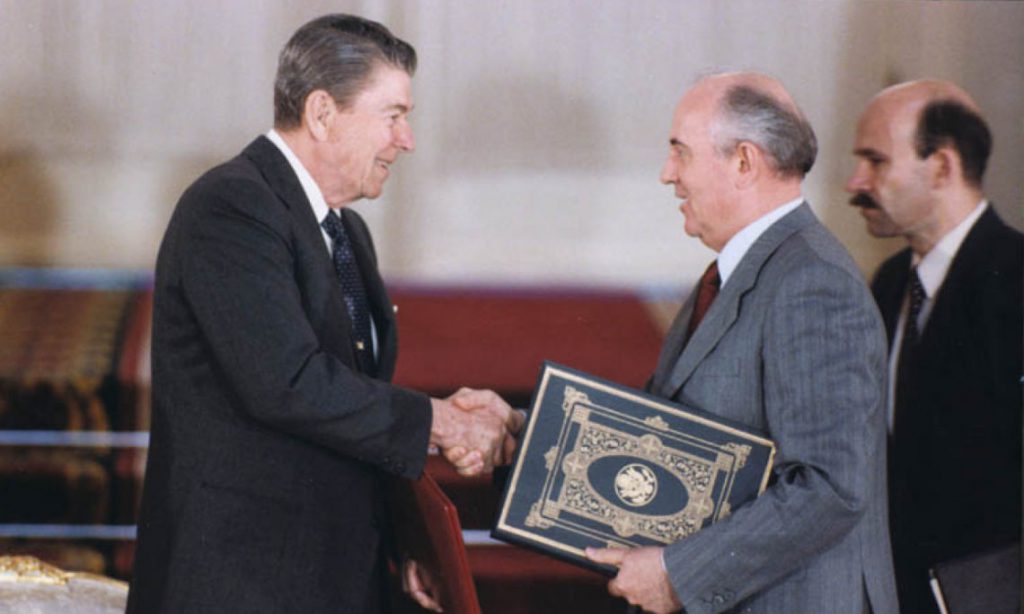
Waste Lands: America’s Forgotten Nuclear Legacy
The Wall St. Journal has compiled a searchable database of contaminated sites across the US. (view)
Related WSJ report: https://www.wsj.com
2022 BLOG POSTS
Nothing Found
It seems we can’t find what you’re looking for. Perhaps searching can help.
New & Updated
Smith: “Trim Budget Fat in America’s Nuclear Triad”
“I would like to kill the low-yield nuclear weapon program. I don’t think it’s a good idea,”
BY JOE GOULD | defensenews.com
WASHINGTON — A powerful skeptic of U.S. nuclear weapons spending, House Armed Services Committee chairman Adam Smith said Tuesday he was open to cutting back quantities of nuclear arms instead of one leg of the nation’s nuclear triad.
“I think a deterrent policy, having enough nuclear weapons to ensure that nobody launches a nuclear weapon at you because you have sufficient deterrent, I think we can do that with fewer warheads,” Smith said. “I’m not sure whether that means getting rid of one leg of the triad or simply reducing the amount in each leg.”
The comments, at the Carnegie Endowment for International Peace’s annual nuclear arms forum, came days after Smith, D-Wash., triggered Republican pushback when he said publicly that the intercontinental ballistic missile leg of the triad is not necessary to deter Russia and China. On Tuesday, Smith seemed to soften on that argument, conceding he believes nuclear weapon systems ought to be modernized but maintaining his stance the U.S. needs fewer nuclear weapons.
Trump budget increases funding for nuclear weapons agency amid new production
BY ARON MEHTA | defensenews.com
WASHINGTON — The National Nuclear Security Administration will receive an 8.3 percent increase over its current budget, with an eye on completing production of a new low-yield nuclear missile this upcoming fiscal year.
/arc-anglerfish-arc2-prod-mco.s3.amazonaws.com/public/26PF65JTNFHVNDRBP5J7OVKX4Q.jpg)
The NNSA, a semiautonomous agency within the Department of Energy that has oversight on America’s nuclear weapons stockpile, is requiring $16.5 billion in the fiscal 2020 budget, up $1.3 billion from its FY19 total. Weapons-related activities would see an allocation of $12.4 billion, an 11.8 percent increase over how much funding went to that mission in FY19. NNSA’s proposed budget comprises 52 percent of the DOE’s total budget request.
“The President’s budget request reflects the Trump Administration’s strong commitment to ensuring that U.S. nuclear capabilities are second to none,” NNSA Administrator Lisa Gordon-Hagerty in a statement. “This vital funding will enable us to continue modernization of the Nuclear Security Enterprise to face 21st century threats.”
DOE reports show WIPP chemical exposure months before workers got sick
Employees fell ill while working both underground and at the service
BY ADRIAN C HEDDEN | Carlsbad Current-Argus
Video by Wochit
Story Highlights
– DOE expressed concerns for WIPP’s airflow months before incidents
– Emplacement and shipments were halted for two weeks in October to address the problem
A federal investigation into operations at the Waste Isolation Pilot Plant near Carlsbad was announced last month, after workers in the underground and on the surface were allegedly exposed to dangerous chemical and excessive heat.
The U.S. Department of Energy’s Office of Enterprise Assessments’ Office of Enforcement announced the investigation on Jan. 29 in a letter to Bruce Covert, president and project manager of Nuclear Waste Partnership – the DOE-hired contractor that oversees daily operations at WIPP.
Fukushima: Eighth Anniversary of a Crippling Nuclear Disaster
BY SOPHIA STROUD | – NukeWatch NM Web Designer
On Friday, March 11, 2011, a 9.0 M earthquake occurred off the East coast of Japan, triggering a massive tsunami in the region of Tohoku. In the Miyagi and Fukushima prefectures of this region, the wave was over 10 meters tall upon landfall. During the 1970s and 80s, coastal residents of Japan welcomed nuclear power, and two plants were built to supply electricity to Tokyo. When the tsunami hit in 2011, many districts of Fukushima lost power, which caused the cooling system in TEPCO’s Fukushima Daiichi nuclear power plant to fail.
This power failure led to a series of nuclear meltdowns and hydrogen-air chemical reactions within the plant, which caused a release of highly radioactive material into the surrounding environment. The radioactive plume released from the Fukushima nuclear power plant was large enough to carry radioactive material for miles in every direction, and nearby residents were immediately evacuated. The Fukushima Daiichi nuclear power plant meltdown and ensuing leakage of radioactive materials was a disaster on the scale of Three Mile Island and Chernobyl.
Trump Budget Would Continue Nuclear Weapons Buildup and Bring More Nuclear Waste to NM
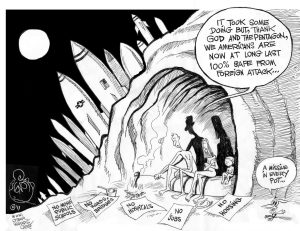
By Scott Kovac, Operations and Research Director
The White House released the top line numbers of its fiscal year 2020 Congressional budget request and, although there are some increases heading to New Mexico, they are not the increases that we’d like to see. It’s called – A Budget For a Better America, Promises Kept. Taxpayers First. but only Defense and Department of Energy (DOE) weapons contractors are going to think that anything is better. Meanwhile the rest of us taxpayers will, first and foremost, be looking at cuts to programs that affect us daily.
Eight years have passed since a tsunami smashed into the Fukushima Daiichi nuclear plant in Japan, sparking a meltdown and the worst atomic crisis since Chernobyl. The disaster zone remains a huge building site with the immediate danger cleared but an immensely difficult clean-up job still looming.
BY KAREN NISHIMURA | phys.org
What is the state of the clean-up?
The clean-up operation is progressing at a painstakingly slow pace. Robotic arms have recently been employed to successfully pick up pebble-sized pieces of radioactive fuel at the bottom of reactor two, one of three that melted down after the 2011 quake and tsunami.
This is the first step to prepare the extremely delicate task of extracting the fuel that will not begin in earnest until 2021 at the earliest, the government and the TEPCO operator have said. Another problem is the fuel pools in reactors one, two and three.
The pool in reactor one is covered in rubble which needs to be removed “with extreme care,” explained Akira Ono, head of the TEPCO subsidiary in charge of decommissioning.
Removing fuel from the pools in reactors one and two will not start until 2023.
For International Women’s Day, here are 7 of history’s greatest women-led protests
Three centuries of female fury over taxes, bread shortages, voting rights and more.

International Women’s Day has been around for more than a century, but it has picked up steam in recent years, thanks to its preeminent hashtagability. What started as socialist demonstrations has now evolved into an official holiday in more than two dozen countries, a United Nations day for women’s rights and world peace, and, well, a marketing opportunity for Barbie dolls, cosmetics and beer (because capitalism).
In honor of the holiday’s more egalitarian roots, here are some regular women in history who gathered together to protest, rebel and, in some cases, riot.
Continue reading
Call to Action: Reauthorize VAWA
Every March, we celebrate Women’s History Month. And today is International Women’s Day, when we recognize the invaluable contributions made by women to every sector of society.
Here in New Mexico, we have a lot to celebrate this International Women’s Day. We have two new congresswomen in Deb Haaland, one of the first Native American women elected to Congress, and Xochitl Torres Small, the first Latina to represent New Mexico’s 2nd Congressional District.
There are now 25 women in the U.S. Senate and 102 in the U.S. House of Representatives — both all-time highs. We celebrate this achievement, but we can’t stop until these numbers increase.
Our work is never finished. And that includes reauthorizing the Violence Against Women Act (VAWA), which is due to expire in the coming months.
VAWA funds new and extended services for victims of domestic violence. It gives law enforcement the tools to identify and prosecute offenders. Its protections for indigenous women are essential in New Mexico.
Without it, many women will have nowhere to turn for help.
This International Women’s Day, we must commit ourselves to reauthorizing VAWA and prioritizing women’s safety. Join me in calling on Congress to do the right thing.
|
How Pakistani Women are Using IWD to Push for Peace with India
BY SABRINA TOPPA | vice.com
Photo by Saad Sarfraz Sheikh
“Women would be the worst-off if a war starts between two nuclear-armed nations,”
– Farooq Tariq, a Lahore-based political activist who helped organise the Global Standout for Peace in South Asia last week.
This year, women are taking a central stand against the region’s long history of conflict, militarism, and war, with both the Aurat March and Aurat Azadi March explicitly denouncing the creep towards war, and exhorting the nuclear-armed neighbours to issue a ceasefire in Kashmir. “We push for peace and against the war, the militarisation of our everyday lives, and a rhetoric of jingoism,” read a statement from Aurat March on Wednesday.
Fukushima at 8: Accusations of scientific misconduct concern city in Japan
Eight years after the Fukushima nuclear reactors exploded on Japan’s Northern coast, spewing radioactive particles into the air, across the land, and into the Pacific Ocean, the country continues to struggle with decontamination and relocation efforts. Determining the health impacts resulting from the nuclear disaster has been particularly fraught. For Date City, about 60 km from the ruined Fukushima reactors, and still blanketed by radioactive contamination from the ongoing catastrophe, the struggle for protection of health continues amid accusations of scientific misconduct and betrayal.
Trump is barreling toward war with Iran. Congress must act to stop him.
BY TOM UDALL & RICHARD J DURBIN | washingtonpost.com
Tom Udall, a Democrat, represents New Mexico in the U.S. Senate. Richard J. Durbin, a Democrat, represents Illinois in the U.S. Senate.
Sixteen years after the U.S. invasion of Iraq, we are again barreling toward another unnecessary conflict in the Middle East based on faulty and misleading logic.
The Trump administration’s Iran policy, built on the ashes of the failed Iraq strategy, is pushing us to take military action aimed at regime change in Tehran. We must not repeat the mistakes of the past, and Congress must act urgently to ensure that.
House Armed Services Committee Ranking Member Adam Smith Opening Statement
Full Committee Hearing on Outside Perspectives on Nuclear Deterrence (As Prepared)
Video link to Chairman Smith’s opening remarks here: https://armedservices.house.gov/ | March 6, 2019
More than a decade ago in a 2007 op-ed George Schultz, Henry Kissinger, William Perry, and Sam Nunn warned that “Unless urgent new actions are taken, the U.S. soon will be compelled to enter a new nuclear era that will be more precarious, psychologically disorienting, and economically even more costly than was Cold War deterrence.” And just last month, Senator Nunn and Secretary Moniz said in a joint op-ed “The US and Russia are sleep-walking toward nuclear disaster.”
“Given the President’s erratic tweets about having “a much bigger and more powerful” nuclear button, we need to ensure that we move away from a button-measuring policy that could devolve into a button-pressing policy.”
Giving the Bomb to Saudi Arabia’s Dr. Strangelove
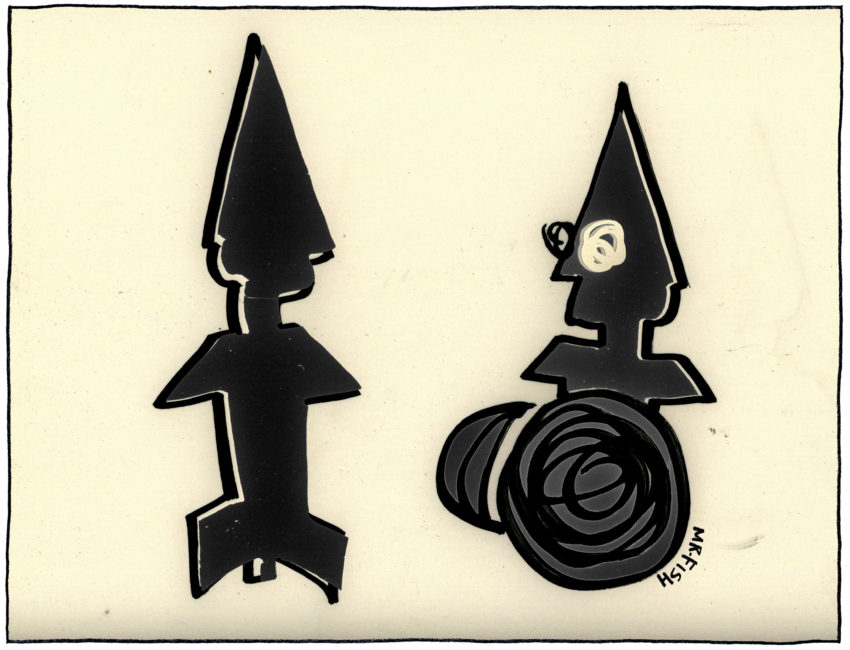 CARTOON BY MR FISH | truthdig.com
CARTOON BY MR FISH | truthdig.com
Mr. Fish, also known as Dwayne Booth, is a cartoonist who primarily creates for Truthdig and Harpers.com.
ARTICLE BY CHRIS HEDGES | truthdig.com
Truthdig columnist Chris Hedges is a Pulitzer Prize-winning journalist and New York Times best-selling author.
The most dangerous foreign policy decision of the Trump administration—and I know this is saying a lot—is its decision to share sensitive nuclear technology with Saudi Arabia and authorize U.S. companies to build nuclear reactors in that country.
A nuclearized Saudi Arabia is a grave existential threat to the Middle East and ultimately the United States.
Why the collapse of a historic nuclear treaty could lead to a Cold War-like arms race
Russia denies its 9M729 land-based cruise missile violates the key nuclear arms pact. (AP: Pavel Golovkin)
The United States and Russia have ripped up a Cold War-era nuclear missile treaty, leaving analysts fearing a potential arms race with global ramifications.
BY TASHA WIBAWA | abc.net.au March 2, 2019
Last week, Russian President Vladimir Putin said Russia was ready for a Cuban Missile-style crisis if the US wanted one, referring to the 1962 standoff that brought the world to the edge of nuclear war.
Decades later, tensions between the two nations are heating up again.
ACTION ALERTS
Nothing Found
It seems we can’t find what you’re looking for. Perhaps searching can help.
Nothing Found
It seems we can’t find what you’re looking for. Perhaps searching can help.
Interfaith Panel Discussion on Nuclear Disarmament - August 9
Nothing Found
It seems we can’t find what you’re looking for. Perhaps searching can help.
New Nuclear Media
Nothing Found
It seems we can’t find what you’re looking for. Perhaps searching can help.

